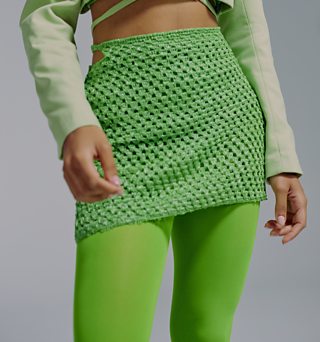Nine things you didn鈥檛 know about miniskirts
In Radio 4 series Torn, historian Gus Casely-Hayford unpicks the hidden histories behind the things we wear – including one of the most controversial articles of clothing ever to exist: the miniskirt.
Here are nine things we learned about one of the stand-out sartorial stars of the Swinging Sixties.
1. Miniskirt designer Mary Quant “didn’t set out to shock”
In 1960s London, Mary Quant was making a name for herself as a designer for the trendy youth of the capital’s Swinging Sixties scene. But it was her miniskirt designs that would catapult her into fashion’s hall of fame. The miniskirt marked the first time in modern history that droves of western women were sporting a hemline above the knee – and it was making waves. However, the designer says she didn’t intend to drop a political bombshell: “I didn’t set out to shock. I wanted to be able to move around, go to work, go out in the evening to somewhere where I could dance half the night away.”

2. Although Mary Quant is seen as queen of the miniskirt, she wasn’t actually its creator
While we talk about Mary Quant as the most influential miniskirt designer, she wasn’t actually the first. André Courrèges was a French fashion designer who made the miniskirt the centre piece of his 1964 space-themed Moon Girl collection. “André Courrèges said, ‘I was the man who invented the miniskirt. Mary Quant just popularised the idea,’” states fashion historian Valerie Steele. “Mary Quant said, ‘Well that’s not how I remember it. It was the girls in the street.’” One thing is for certain, as soon as the miniskirt was born, young women were desperate to get their hands on one.
3. The miniskirt was a rejection of wartime austerity
When Mary Quant was designing miniskirts, she was also looking to leave behind the depressing years of both history and fashion. “Rationing became even more fierce,” says the designer. You needed coupons in order to buy new clothes. It was “desperately gloomy, and so it had to be livened up and kicked a bit.”
4. Miniskirts had a lot in common with the flapper skirts of the 1920s
The girls of the late 1950s through to the 60s had something in common with the girls of the 1920s, says Valerie. In the 20s, flapper skirts reached the knee and might lift even higher when the wearer spun on the dancefloor. “Both of these were periods when young people were dominating the cultural scene, and in both cases in response to a rejection of the older generation,” says Valerie. “A rejection of the older generation that led them into World War I, and then also led them into the Vietnam War.”
5. The miniskirt took longer to catch on in the United States
The miniskirt was a slow burner across the pond. In the United States they were still seen as shockingly short by many and created conflicting views in women. Pioneer feminist Betty Friedan saw miniskirts as sexist symbols or little doll outfits that hampered serious pursuits. On the other hand, the American feminist Gloria Steinem argued that sporting a miniskirt was a transgressive act and she wore them to rallies. The Washington Post called her “the miniskirted pin-up girl of the intelligentsia”.

"They're like big belts, Doreen!"
Eve Shrewsbury shocked the older generation in her rural village by wearing a miniskirt.
6. The miniskirt lost popularity in the 1960s
In the late 1960s, after just a few years of the miniskirt’s existence, more and more women were beginning to reject the skirt generally in favour of trousers and unisex clothes. And as the pendulum of fashion swung, the miniskirt started to lose its popularity. By 1970, the miniskirt adorers were lamenting its passing.

7. … But then it had a resurgence in the 1980s
“The miniskirt becomes a lot of women’s individual decision again in the 1980s, when there’s a turn away from trousers towards a kind of sex and power feminism,” says Valerie. “Yes, you could wear pink; yes, you could wear a skirt. It might be a suit but with a short miniskirt instead of trousers… Why should you try and look like a man? You could be a powerful, sexy woman.”
8. Miniskirts were banned in China
The controversies over whether women should wear miniskirts has sometimes taken serious turns. “You find very strong, violent reactions against this,” says Valerie. “In China, miniskirts were regarded as bourgeois Western fashion and therefore were unacceptable,” explains the historian. “The Red Guards would attack any woman who wore a miniskirt.” (They would also punish any man whose hair started to grow too long or whose trousers seemed to be too tight.)
9. One miniskirt started a social media movement
Controversy over the miniskirt remains to this day. In Little Rock, Arkansas, in 2019, senior high school student Clara Mitchell dressed in what she considered a “professional”-looking plaid skirt to present at her school science symposium. But she was told by staff that the skirt was too short, and she would need to change before taking to the stage. Clara’s close friend Laura Orsi was outraged on her behalf and began an Instagram movement called “Pass the Skirt”. Others jumped at the chance to talk about the times they had been “dress coded”. Some even used the hashtag (#PassTheSkirt) to organise school protests where they would wear miniskirts in political solidarity.
More from 麻豆社 Radio 4
-
![]()
Just One Thing
If time is tight, what's the one thing that you should be doing to improve your health and wellbeing? Michael Mosley reveals surprisingly simple top tips that are scientifically proven to change your life.
-
![]()
You're Dead To Me
The comedy podcast that takes history seriously. Greg Jenner brings together the best names in comedy and history to learn and laugh about the past.
-
![]()
Unreal: A Critical History of Reality TV
Journalists Pandora Sykes and Sirin Kale explore how reality TV shapes our lives and the ethical questions raised by the format, featuring iconic shows and stars.
-
![]()
One Dish
What's the one dish that holds a special place in your heart? Andi Oliver and her special guests are on a quest to discover the stories and science behind our favourite foods.





